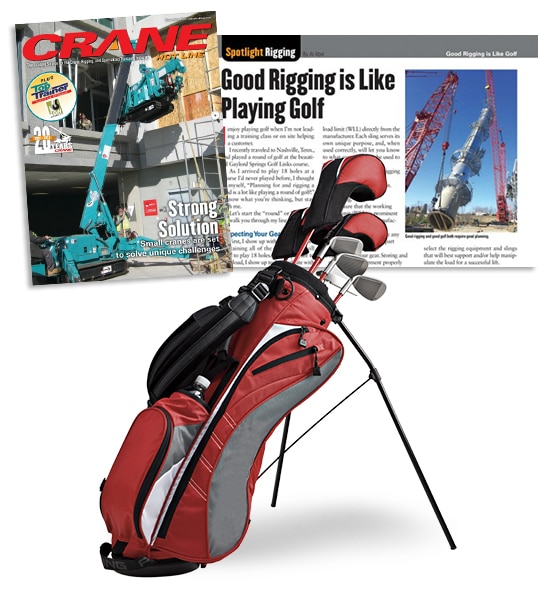Rigging a Load – Just Like Playing A Round of Golf!
Crane Hotline Magazine (November 2017)
Written by Al Abel – Lifting Specialist, Mazzella Lifting Technologies
I enjoy playing golf when I’m not leading a training class or on-site helping out a customer. I recently traveled to Nashville and played a round of golf at the beautiful Gaylord Springs Golf Links course.
As I arrived to play 18 holes at a course I’ve never played before, I thought to myself, “Planning for and rigging a load is a lot like playing a round of golf!” I know what you’re thinking … but stay with me. Let’s start the “round” or “lift” and I’ll walk you through my line of thinking!

Inspecting Your Gear.
First, I show up with my bag of clubs containing all of the equipment I will need to play 18 holes. If I was preparing to lift a load, I show up to the work site with all of my rigging equipment and gear that I’ll need to safely execute a lift.
Before the golf round begins, I inspect my clubs and golf equipment to make sure that I don’t see any issues or damage that may prevent me from using them or may affect the quality of my game. All of my clubs are facing “head up” in my bag, so I can easily identify each club. Each club has its own purpose and each club has a specific distance rating—when used correctly, I know the distance that the club is capable of hitting the ball.
On the job site, you inspect your rigging equipment before performing a new lift — just like you would inspect your golf gear before teeing off on the first hole. All slings should be clearly identified with a legible tag that gives you the Working Load Limit (WLL) directly from the manufacturer. Each sling serves its own unique purpose and when used correctly, will let you know to what capacity it can be used to perform a lift.
When inspecting your rigging gear, you:
- Perform a visual inspection
- Check the condition of each sling
- Make sure that the Working Load Limit (WLL) is prominent and you know who manufactured the equipment
- Quarantine and do not use any equipment that fails any part of the inspection process
- Take care of your gear — properly storing it and maintaining it in between uses will prolong the life of the equipment
Following A Plan.
On the golf course, once I’m ready to tee off I grab my clubs that I inspected and make sure I have all of my proper PPE — golf glove, golf shoes, hat, sunglasses, sunscreen, etc. I grab a scorecard and step onto the tee box. I survey the layout of the hole and identify the distance and yardage and decide which clubs I’m going to use to complete the hole successfully.
On the job site you take similar factors into consideration. Your proper PPE may be steel-toe boots, safety glasses, safety vests, and a hardhat — but you make sure you have all of it with you for any situation that you may encounter.
You may not have a scorecard, but you do have a drawing or bill of lading — something that shows you the challenge that lays ahead—and you know the weight of the load like you would the distance to the hole.
Just like you would select the best club for the distance and lie of the ball on the hole, you select the pieces of rigging equipment and slings that will best help to support and/or manipulate the load for a successful lift.
The Action … And The Results.
The lift begins … the shot is in the air.
The load sets down nicely in the designated area … the ball falls softly on the green.
The slings come off of the load … the ball rolls steadily into the cup! Success!
From proper selection and inspection of your equipment to considering all of the different factors that will equate to failure or success — planning a lift is a lot like playing a round of golf.
If you plan and you execute, successful rounds and successful lifts can be achieved. You’ll find yourself in trouble when you do not center yourself over the ball, or find the center of balance of your load.
If you rush your backswing or rush your lift, problems can occur! Keep your swing under control and keep your load under control!
You can be a successful golfer or a successful rigger. Practice safe rigging concepts and you should have success on any course that you play. FORE!
